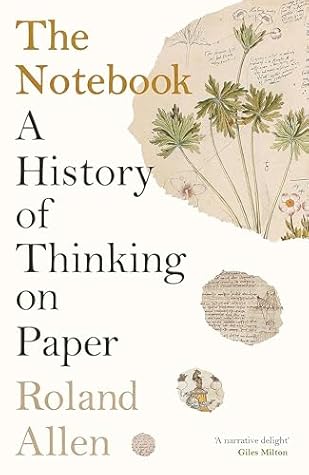More on this book
Community
Kindle Notes & Highlights
The Notebook Introduction
The original Moleskine had launched at the same time as the Palm Pilot, the first hand-held digital organiser, and had from day one faced competition from increasingly powerful devices. The laptop, the BlackBerry, the iPhone and the iPad all seemed to offer far greater functionality than their paper antecedent, but a stubborn constituency of users refused to move over into the digital sphere, and numerous peer-reviewed studies soon showed that their obduracy made sense.
Chapter 1 Before notebooks The Mediterranean 1000 BCE–1250
Chapter 2 Red book, white book, cloth book
Chapter 3 Slight strokes in a little book The sketchbook, Florence 1300–1500
As any artist in training learns, all these new techniques – light and shade, form, mass, the observation of drapery, proportion, perspective, pose, and the capture of likeness and personality – can only be developed in one way: drawing, and lots of it.
And, at a tenth of the price of parchment, cheap paper allowed artists to ‘always and without fail draw something every day’.
Chapter 4 Ricordi, ricordanzi, zibaldoni
No-one knows exactly when the gloriously sonorous noun zibaldone
The basic principle was simple: when you found a piece of writing that you liked, or found useful, you copied it out into your personal notebook.
for Dante to become Dante – scribal reproduction would not alone suffice. His writings were transmitted to a much larger, more diverse, audience, by thousands of ordinary people copying favourite texts from zibaldone to zibaldone,
So notebooks democratised literature by giving readers another way to read; but they also gave writers another way to write.
Chapter 5 Pepper in Alexandria The Book of Michael of Rhodes, Venice 1434
Chapter 6 Wicked wives and mouths stopped with wool
Chapter 7 The long life of LHD 244 Singing in harmony, Bologna c.1450–1600
This habit of drawing engaged one of his most important analytical tools: analogy.
Chapter 9
It was up to each reader to assemble their ‘mass of material’ according to their needs, and to logically arrange each selection, by topic, in ‘common places’.
once an excerpt was in place, juxtaposition with what had already been written tended to generate further shades of meaning.
Finally, the well-arranged common-place functioned as a kind of externalised memory, which, as historian Ann Blair notes, ‘liberated the reader from the task of memorising the selected passages’.
writers started to self-consciously create quotable texts with common-placing readers in mind – seventeenth-century soundbites.
Speeches and sermons usually ran on at lengths that we would today find intolerable, as their authors crammed in as many quotations, citations and precedents as they could.
Chapter 12
Stammbücher changed over time,
As the notebooks became part of university life, he told me, conventions duly developed around their use.
students would not only ask their professors, and other local worthies, for their signatures, but their friends, too. Ent...
This highlight has been truncated due to consecutive passage length restrictions.
In Wittenberg and Amsterdam, they had blank books; today we have Facebook and LinkedIn,
Chapter 13
Heinrich Schickhardt
‘There were no engineering schools, or architectural schools, at the time,’ he told me. ‘Travelling was more or less obligatory.’ To pick up new ideas, in particular from the industrial hot spots of Italy and the Netherlands, you had to go and see them with your own eyes.
Chapter 14
English polymath Francis Bacon
1587 essay On Travel he offered note-taking advice to young men heading overseas:
It is a strange thing, that in sea voyages, where there is nothing to be seen, but sky and sea, men should make diaries; but in land-travel, wherein so much is to be observed, for the most part they omit it; as if chance were fitter to be registered, than observation. Let diaries, therefore, be brought in use.
historians often learn more about a place from notes made by visitors than from records left by residents.
Outsiders tend to be more acute observers than natives.
The Life and Strange Surprizing Adventures of Robinson Crusoe, which first came out in 1719,
Far more commerically successful than Melville, Mark Twain carried notebooks everywhere too, having got into the habit while training to become the ‘cub’ pilot of a Mississippi steamboat.
chief, one Horace Bixby, tested young Samuel Clemens – Twain’s real name – on the stopping points above New Orleans. When the boy failed to recall any, Bixby offered the advice which Clemens subsequently lived
‘My boy, you must get a little memorandum-book, and every time I tell you a thing...
This highlight has been truncated due to consecutive passage length restrictions.
Chapter 15 The Waste Book Mathematics, Lincolnshire 1612
Now Hannah’s oldest son could live with his mother and his infant half-siblings, in the family home, with the late Smith’s large spiritual library and gargantuan unfinished common-place book. Never accepted by Smith, and probably traumatised by his
mother’s abandonment, the boy bore both the forename and surname of his late father, the illiterate yeoman he had never known: Isaac Newton.
Waste Book. He meant nothing derogatory in this: for bookkeepers, and therefore all writers of the period, a ‘waste book’ was the place you made your first notes, on the fly.
But mathematicians remained hopeless in the face of movement: they could not calculate, or describe, the flight of a ball, the orbit of a moon, or the acceleration of a falling object, in objective numerical terms. This was the challenge that Newton set himself: the mathematics of fluxions, which we today know as calculus.
Newton didn’t want people to think that his ideas had developed in dialogue with other mathematicians, so he later presented the text ‘without those tell-tale references, to make it look as if the calculus as it was practised in the 1690s had sprung suddenly to his mind, thirty years earlier’.
Chapter 16 A tale of two notebooks Fouquet and Colbert, Paris 1661–80


